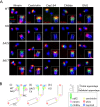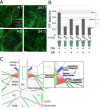Two appendages homologous between basal bodies and centrioles are formed using distinct Odf2 domains
- PMID: 24189274
- PMCID: PMC3824012
- DOI: 10.1083/jcb.201303071
Two appendages homologous between basal bodies and centrioles are formed using distinct Odf2 domains
Abstract
Ciliogenesis is regulated by context-dependent cellular cues, including some transduced through appendage-like structures on ciliary basal bodies called transition fibers and basal feet. However, the molecular basis for this regulation is not fully understood. The Odf2 gene product, ODF2/cenexin, is essential for both ciliogenesis and the formation of the distal and subdistal appendages on centrioles, which become basal bodies. We examined the effects of Odf2 deletion constructs on ciliogenesis in Odf2-knockout F9 cells. Electron microscopy revealed that ciliogenesis and transition fiber formation required the ODF2/cenexin fragment containing amino acids (aa) 188-806, whereas basal foot formation required aa 1-59 and 188-806. These sequences also formed distal and subdistal appendages, respectively, indicating that the centriole appendages are molecularly analogous to those on basal bodies. We used the differential formation of appendages by Odf2 deletion constructs to study the incorporation and function of molecules associated with each appendage type. We found that transition fibers and distal appendages were required for ciliogenesis and subdistal appendages stabilized the centrosomal microtubules.
Figures





Similar articles
-
Odf2-deficient mother centrioles lack distal/subdistal appendages and the ability to generate primary cilia.Nat Cell Biol. 2005 May;7(5):517-24. doi: 10.1038/ncb1251. Epub 2005 Apr 24. Nat Cell Biol. 2005. PMID: 15852003
-
Essential role of Cenexin1, but not Odf2, in ciliogenesis.Cell Cycle. 2013 Feb 15;12(4):655-62. doi: 10.4161/cc.23585. Epub 2013 Jan 23. Cell Cycle. 2013. PMID: 23343771 Free PMC article.
-
Molecular dissection of ODF2/Cenexin revealed a short stretch of amino acids necessary for targeting to the centrosome and the primary cilium.Eur J Cell Biol. 2008 Mar;87(3):137-46. doi: 10.1016/j.ejcb.2007.10.004. Epub 2008 Jan 2. Eur J Cell Biol. 2008. PMID: 18171590
-
A centriole's subdistal appendages: contributions to cell division, ciliogenesis and differentiation.Open Biol. 2021 Feb;11(2):200399. doi: 10.1098/rsob.200399. Epub 2021 Feb 10. Open Biol. 2021. PMID: 33561384 Free PMC article. Review.
-
Structure and function of distal and subdistal appendages of the mother centriole.J Cell Sci. 2023 Feb 1;136(3):jcs260560. doi: 10.1242/jcs.260560. Epub 2023 Feb 2. J Cell Sci. 2023. PMID: 36727648 Review.
Cited by
-
Pericentriolar matrix (PCM) integrity relies on cenexin and polo-like kinase (PLK)1.Mol Biol Cell. 2022 Aug 1;33(9):br14. doi: 10.1091/mbc.E22-01-0015. Epub 2022 May 24. Mol Biol Cell. 2022. PMID: 35609215 Free PMC article.
-
NUP98 Sets the Size-Exclusion Diffusion Limit through the Ciliary Base.Curr Biol. 2018 May 21;28(10):1643-1650.e3. doi: 10.1016/j.cub.2018.04.014. Epub 2018 May 3. Curr Biol. 2018. PMID: 29731308 Free PMC article.
-
Intraflagellar Transport and Ciliary Dynamics.Cold Spring Harb Perspect Biol. 2017 Mar 1;9(3):a021998. doi: 10.1101/cshperspect.a021998. Cold Spring Harb Perspect Biol. 2017. PMID: 28249960 Free PMC article. Review.
-
Hierarchical assembly of centriole subdistal appendages via centrosome binding proteins CCDC120 and CCDC68.Nat Commun. 2017 Apr 19;8:15057. doi: 10.1038/ncomms15057. Nat Commun. 2017. PMID: 28422092 Free PMC article.
-
Requirement of NPHP5 in the hierarchical assembly of basal feet associated with basal bodies of primary cilia.Cell Mol Life Sci. 2020 Jan;77(1):195-212. doi: 10.1007/s00018-019-03181-7. Epub 2019 Jun 8. Cell Mol Life Sci. 2020. PMID: 31177295 Free PMC article.
References
-
- Bouckson-Castaing V., Moudjou M., Ferguson D.J., Mucklow S., Belkaid Y., Milon G., Crocker P.R. 1996. Molecular characterisation of ninein, a new coiled-coil protein of the centrosome. J. Cell Sci. 109:179–190 - PubMed
Publication types
MeSH terms
Substances
LinkOut - more resources
Full Text Sources
Other Literature Sources
Molecular Biology Databases
Miscellaneous

